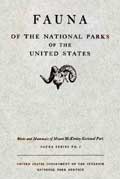.gif)
MENU
|
Fauna of the National Parks — No. 3
Birds and Mammals of Mount McKinley National Park |

|
Birds
DESCRIPTIONS OF BIRD SPECIES
LITTLE BROWN CRANE
Crus canadensis canadensis [LINNAEUS]
GENERAL APPEARANCE.—A large cranelike bird of dull, uniform brownish color with long legs and a long neck. It is without any plume or crest on the head. The forehead and crown are covered with a thin growth of red hairlike feathers. Length, 35.5 inches.
IDENTIFICATION.—The rolling call note, the tall erect form, the red crown and, in flight, the long fully extended neck and legs are all good characters of this bird.
DISTRIBUTION.—The little brown crane belongs to a northern race breeding along the Arctic coasts of North America and Siberia.
HABITS—Little brown cranes pass through the McKinley region each spring and fall. The earliest spring arrivals were noted at Wonder Lake on May 15, 1927, at 2 p. m., by Mr. and Mrs. John E. Anderson. The fall migration was recorded at Wonder Lake in 1928 as follows: September 1, first flock of 120 cranes were noted flying south at 3 p. m. September 2, at 6 p. m., approximately 300 cranes were flying south. The crane migration peak was reached on September 9, when about 4,000 cranes were seen—the flocks were flying south all day. On September 10, about 1,000 cranes were counted; the migration continued through the 13th and the 15th—approximately 500 being noted each day. The last flock of 28 cranes flew south over Wonder Lake at 2 p. m. on September 26.
In 1932, I noted the first fall migration on the evening of August 31, when I noted a flock of more than 200 little brown cranes flying eastward. The migrating cranes formed two rounded waving lines—the formation was not sharply V-shaped as it is in geese migrations. I could distinctly hear the loud rolling call notes of the clamoring cranes. This flight followed the first good snowstorm of the fall when the weather was clear but cold.
NEXT >>>
 Top
Top
Last Modified: Thurs, Oct 4 2001 10:00:00 pm PDT
http://www.cr.nps.gov/history/online_books/fauna3/fauna9f.htm
![]()
